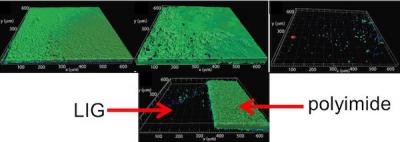Researchers at Rice University and Ben-Gurion University of the Negev in Israel (BGU) have shown that laser-induced graphene LIG (that was invented at Rice) is a highly effective anti-fouling and anti-biofouling material (that protects surfaces from the buildup of microorganisms, plants or other biological material on wet surfaces), and, when electrified, also serves as a bacteria zapper.

This form of graphene is extremely resistant to biofilm formation, which has promise for places like water-treatment plants, oil-drilling operations, hospitals and ocean applications like underwater pipes that are sensitive to fouling, Prof. James Tour says. The antibacterial qualities when electricity is applied is a great additional benefit.
When used as electrodes with a small applied voltage, LIG gains the ability to 'zap' bacteria. When tested without the charge, it was shown that graphene-based nanoparticles have antibacterial properties - which is not a new idea. However, when 1.1 to 2.5 volts were applied, the LIG electrodes greatly enhanced those properties.
Microscopic tests showed that fluorescently tagged Pseudomonas aeruginosa bacteria in a solution with LIG electrodes above 1.1 volts were drawn toward the anode. Above 1.5 volts, the cells began to disappear and vanished completely within 30 seconds. At 2.5 volts, bacteria disappeared almost completely from the surface after one second.
The BGU lab tested LIG electrodes in a bacteria-laden solution with 10% secondary treated wastewater and found that after nine hours at 2.5 volts, 99.9% of the bacteria were killed and the electrodes strongly resisted biofilm formation.
The researchers speculate that the bacteria-killing mechanism relies on a combination of contact with the rough surface of LIG, the electrical charge and toxicity from localized production of hydrogen peroxide. "Fortunately, LIG’s anti-fouling properties keep dead bacteria from accumulating on the surface", Tour says.
The combination of passive biofouling inhibition and active voltage-induced microbial removal will likely make this a highly sought-after material for inhibiting the growth of troublesome natural fouling that plagues many industries, according to Prof. Tour.